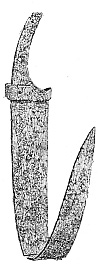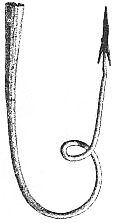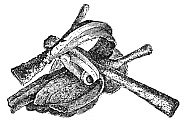| Author |
Message |
|
Dmitry Z~G
|
 Posted: Wed 24 Nov, 2010 8:21 pm Post subject: Bent weapons found In Viking digs. Posted: Wed 24 Nov, 2010 8:21 pm Post subject: Bent weapons found In Viking digs. |
 |
|
I would welcome your input on the subject of bent swords and other edged weapons sometimes found in the viking excavations.
Was this bending done by the human hand on purpose, or was it a result of being subjected to the heat of the burning funeral pyres?
Some illustrations from Paul du Chaillou's The Viking Age -
 Attachment: 26.36 KB Attachment: 26.36 KB

 Attachment: 25.5 KB Attachment: 25.5 KB

 Attachment: 30.72 KB Attachment: 30.72 KB

|
|
  |
 |
Nathan Beal

|
 Posted: Wed 24 Nov, 2010 9:14 pm Post subject: Posted: Wed 24 Nov, 2010 9:14 pm Post subject: |
 |
|
In short your guess is as good as mine.
The odds are some of these (at least) were intentionally bent (the resultant shapes are unlikely from then getting to hot) Why we don't know, typically those explaining this ascribe a ritual element to the practice, the idea of ritually 'killing' or destroying the weapon is often expressed. We honestly have no firm details on why they did this, we know it is a practice that pre-dates the viking age however.
Not aware of any metallurgical studies examining the alignment of the internal structure to prove any particular blade was bent/warped by a heating process, but perhaps others are. That would help answer your question on how.
HTH
N.
Beware of dragons, for you are crunchy and good with ketchup.
|
|
  |
 |
|
Peter Johnsson
Industry Professional
|
 Posted: Wed 24 Nov, 2010 11:11 pm Post subject: Posted: Wed 24 Nov, 2010 11:11 pm Post subject: |
 |
|
These objects come from Danish bog finds. They are part of huge weapon offerings and date to the roman iron age. They predate the viking age with half a millennia or so.
Much of the weapons and warrior equipment were intentionally destroyed (ritually "killed") before being thrown into the shallow lakes that later became bogs.
|
|
   |
 |
Romulus Stoica

Location: Hunedoara, Transylvania, Romania Joined: 26 Oct 2006
Posts: 124
|
 Posted: Thu 25 Nov, 2010 12:45 am Post subject: Posted: Thu 25 Nov, 2010 12:45 am Post subject: |
 |
|
|
A somehow similar example of "ritual killing" of a mail shirt (armor) this time, was found in Hunedoara, Transylvania, Romania. In a dacian burial. It seems that the mail shirt was cut in pieces with a chisel before it was placed in the grave.
|
|
   |
 |
|
Stephen Wheatley
Location: DORSET ENGLAND Joined: 15 Nov 2008
Posts: 93
|
 Posted: Thu 25 Nov, 2010 1:02 am Post subject: NYDAM / THORSBJERG MOSE - ILLERUP Posted: Thu 25 Nov, 2010 1:02 am Post subject: NYDAM / THORSBJERG MOSE - ILLERUP |
 |
|
These finds predate the viking period in Denmark, indeed, they predate the Danes in Denmark themselves although reading Glob's ''the Bog People'' you wouldn't think it. The weapons finds date from the time that the Jutes and Angles (English) lived in those parts; a west teutonic folk but with strong Scandinavian affinities and possibly Swedish royalty (wulfings - wuffingas). The Danes at the time posessed Zealand and Skane and moved into Fyn and Jutland in the fifth and six centuries following the departure of the English and their more southerly chums, the Saxons, in their expansion into Britain.
Thus, the finds are not ''Viking'' weapons, some, if not most are pre volkwanderung and are Roman and Germanic iron age types. Tacitus has recorded a northern people, probably the Anglii throwing captured weapons and prisoners into lakes to honoue their god of war (Tiwas, Tiw/Tyr). Nice. Great to be the offspring of folk with such a sense of fun!
Stephen Wheatley
|
|
  |
 |
|
Ken Speed
|
 Posted: Thu 25 Nov, 2010 3:00 am Post subject: Posted: Thu 25 Nov, 2010 3:00 am Post subject: |
 |
|
|
As many have written we don't know why weapons in burials were bent. The notion that the weapon was being "killed" to accompany the deceased into the afterlife is often suggested. I can only offer this as conjecture but there are mentions in literature of weapons being stolen from graves; I think it is possible that these weapons were not killed so much as spoiled to prevent someone from grave robbing them their own use.
|
|
  |
 |
|
Till J. Lodemann
|
 Posted: Thu 25 Nov, 2010 5:08 am Post subject: Posted: Thu 25 Nov, 2010 5:08 am Post subject: |
 |
|
We have to distinguish between gravegoods and bog sacrifices.
The custom to bend swords and lanceheads for burials is a cetlic tradition which has been absorbed by many germanic tribes together with cremation burials. As they changed to inhumation burials, the destruction of weapons ceded also.
I guess there was a religious thing behind the destruction of the weapons, but also the fear of graverobbing. We have indeed plentifull evidence of this for any time in history and prehistory.
The other thing are the bog sacrifices, a northern germanic custom which took place between 350 bc (Hjortspring sacrifice) and the middle of the 5th century AD (e.g. Nydam II)
The generally consist of an enormous number of weapons and general equipment of unsuccessfull invading armies, including several warships, hundreds of swords lances, spearheads, shields, axes arrows and bows.
Due to the special chemical conditions in the soil most of the organic parts of the sacrifices have been preserved.
Latest excavations also revealed the sacrifice of up to a thousend human individuals ( though sacrificed at several different occasions) at the bog of Illerup Ådal.
The destruction of weapons is only casual here. But there are traces that some of the damage was done after the battle, like the spearhead you posted. Ther might have been a ritual destruction of a part of the sacrifice.
Especially precious and prestigous pieces have been destroyed. For example, the red tunic and trousers from Thorsberg have been literally cut into pieces, same goes for the pseudocorinthian roman cavalry helmet from this bog. The shields have been smashed into pieces by axes and the bosses look like a madman with a big hammer hah his way with them.
And in Nydam I, one third of all spearheads (278 in total) have been bent. The one Dmitry posted is an example for them. Definatly no battle damage.
|
|
  |
 |
Elling Polden

|
 Posted: Thu 25 Nov, 2010 6:50 am Post subject: Posted: Thu 25 Nov, 2010 6:50 am Post subject: |
 |
|
Though the examples posted are pre-viking age, deliberate destruction of weapons is also a well known phenomenon in the viking period.
Quite possibly the motivation is to deter looting, or perhaps to make a more "tangible" sacrifice than simply burying the item.
However, this practice was not universal; It appears most swords where buried without being destroyed.
Leafing thorugh the University Museum database, you can see lots of examples of bent blades;
http://www.unimus.no/arkeologi/#/listView?div...tRecord=32
"this [fight] looks curious, almost like a game. See, they are looking around them before they fall, to find a dry spot to fall on, or they are falling on their shields. Can you see blood on their cloths and weapons? No. This must be trickery."
-Reidar Sendeman, from King Sverre's Saga, 1201
|
|
    |
 |
Jean Thibodeau

|
 Posted: Thu 25 Nov, 2010 10:06 am Post subject: Posted: Thu 25 Nov, 2010 10:06 am Post subject: |
 |
|
Just a hypothesis about why the arms, armour, clothing where destroyed to accompany the deceased:
A dead person is essentially a " broken " person and this is why they are dead: In the world of the living they appear damaged or decayed but in the after life they would be back to their selves when they where at there best and strongest.
In some cases maybe destroying the object is " killing " the object: In our World of the living the object ( sword ) has now been killed and although damaged for the living it has now crossed over into the World of the dead and for the dead back to their best as new shape.
So to send the sword to the dead it is killed, what we see as a damaged sword is now an intact sword that is now in the hands of the warrior.
Anyway, this is just a theory of how the people of the time thought processes and motivations ?
You can easily give up your freedom. You have to fight hard to get it back!
|
|
  |
 |
|
Dmitry Z~G
|
 Posted: Thu 25 Nov, 2010 2:41 pm Post subject: Posted: Thu 25 Nov, 2010 2:41 pm Post subject: |
 |
|
|
The natural question arises - why not just break the blades in two [or more] segments? It would, to me, seem far easier than heating the blade and then bending it, assuming we're dealing with steel, and not iron.
|
|
  |
 |
|
Aleksei Sosnovski
|
 Posted: Thu 25 Nov, 2010 10:54 pm Post subject: Posted: Thu 25 Nov, 2010 10:54 pm Post subject: |
 |
|
| Dmitry Z~G wrote: | | The natural question arises - why not just break the blades in two [or more] segments? It would, to me, seem far easier than heating the blade and then bending it, assuming we're dealing with steel, and not iron. |
Breaking a blade is not that easy. And if we are speaking about viking age,swords were of very different quality. Some would break easily, others would be very springy and difficult to break, and yet others would be too soft and would simply bend. As far as I remember there were finds where swords were not only bent, but also deeply nicked by axes to make them totally useless (it is possible to straighten a bent blade and then heat treat it again, or even use without heat treatment, after all there are finds of swords made entirely of soft iron, but if a sword has deep nicks it is useless).
Actually burning and bending is easier. Every house had a fireplace. Throw a blade there, then take it out, let it cool and bend it. Much easier then trying to break a good sharp blade with bare hands or an axe/hammer at best.
And, burning the blade could also have some religious/ceremonial meaning. For example burning weapons could originate from cremation burials and then outlive the "parent" tradition due to its utilitarian usefulness.
|
|
   |
 |
|
|
You cannot post new topics in this forum
You cannot reply to topics in this forum
You cannot edit your posts in this forum
You cannot delete your posts in this forum
You cannot vote in polls in this forum
You cannot attach files in this forum
You can download files in this forum
|
All contents © Copyright 2003-2025 myArmoury.com — All rights reserved
Discussion forums powered by phpBB © The phpBB Group
Switch to the Basic Low-bandwidth Version of the forum
|

